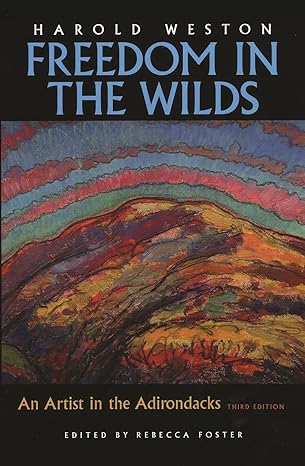The story of events shaped in the past always seems to interest us living in the present. People are incessantly intrigued by various accounts, especially concerning our Adirondacks. Harold Weston, the famed painter of St. Hubert’s, felt the urge to record some of his memories in a book called Freedom in the Wilds. His own statement in the preface sums up his purpose quite adequately:
“I make no claim that this is a definitive or accurate historical record, though a great many sources have been consulted and tall tales checked. Frankly, I care far more about the future than the past and about the significance of events rather than data or details. This saga reflects the memories, experiences, and reactions of only one man, an artist, during large portions of a lifetime in a very limited neck of the woods.”
How true. The book is centered around events occurring during his life from the turn of the century until 1971 in the St. Hubert’s, Keene Valley region of the Adirondacks. It is a rare book that casually informs us of incidents in this time period, without leaving us steeped in literary drollness. The book’s structure is a loose organization of history, tales, and adventures. Very few mountain authors have been able to enlighten the public with this style of presentation.
Weston weaves his story in a flowing, cumulative saga. Beginning with various incidents and happenings around 1800, we learn about the lifestyles of the Adirondack pioneers. Most interesting is the passage concerning the Chapel Pond/ Route 73 road. During the Revolutionary War, British General Burgoyne had his men open a road from AuSable Forks through Chapel Pond Pass to the Schroon Valley. In total surprise, he was able to overwhelm the Americans at Fort Ticonderoga. Since then, the road has been rebuilt and has opened up Keene Valley to the population in the rest of the state.
In 1872, a man named Verplanck Colvin was responsible for surveying a majority of the present High Peak region. His adventures and surveys proved to be extremely valuable in initiating the formation of the Adirondack Park and the Forever Wild principle in 1894. Without Colvin’s drive and energy, the establishment of the Park might not have occurred.
In the same era, much of the wilderness was being bought up by logging industries. In 1886, William G. Neilsen and W. Charles Alderson became aware of the possible loss of the prime forest area in the state. They formed a corporation called the Adirondack Mountain Reserve to preserve the wild areas. By raising $80,000, the AMR bought the majority of land in the AuSable Lakes Valley. Today, one can appreciate the wildness, beauty, and serenity in this lovely valley.
Soon after the land acquisition, the Adirondack Trail Improvement Society was formed to sustain this land with trails and overall conservation. During the 20’s and 30’s, Harold Weston was very active in the ATIS.
During this time, many people enjoyed the Keene Valley region, even more than today. Harold Weston had decided to pursue the career of a painter, building a cottage in St. Hubert’s. Here, he began to capture many invigorating landscapes of the region with his paintbrush. Unfortunately, many of the photos of his work published are in black and white. If possible, one must view them in their natural state, in color; only then can one be truly awed at the beauty revealed in his work.
At the outbreak of World War 2, Weston was instrumental in forming the United Nations Relief and Rehabilitation Administration. Without his efforts, the Marshall Plan, the goal to revitalize the wartorn nations, might never have occurred. After this effort, he became very involved in the Art world, especially organizing the National Council on the Arts and Government. This council was monumental in recognizing the government’s role in sustaining the arts.
In the late 1960’s, Weston became involved in Abstract painting. During this period, his works were stimulated by four small stones given to him as a gift. Once again, the B & W reproductions do not serve the originals justice. At this time, he began to compile Freedom in the Wilds.
For anyone interested in this Keene Valley region, this book is a landmark. Many, many more accounts can be listed and discussed, but in order to savor each event recorded, going directly to the source will surely satisfy any Adirondack lover.

